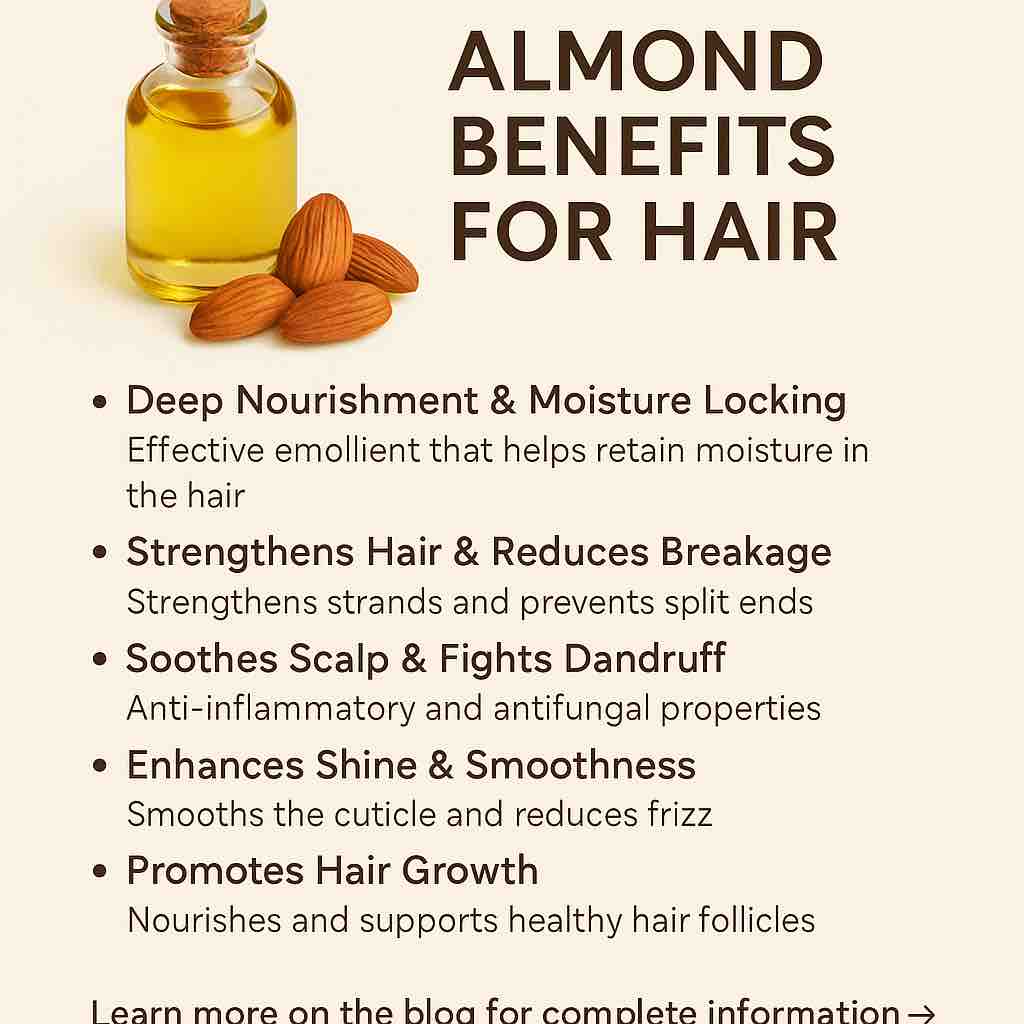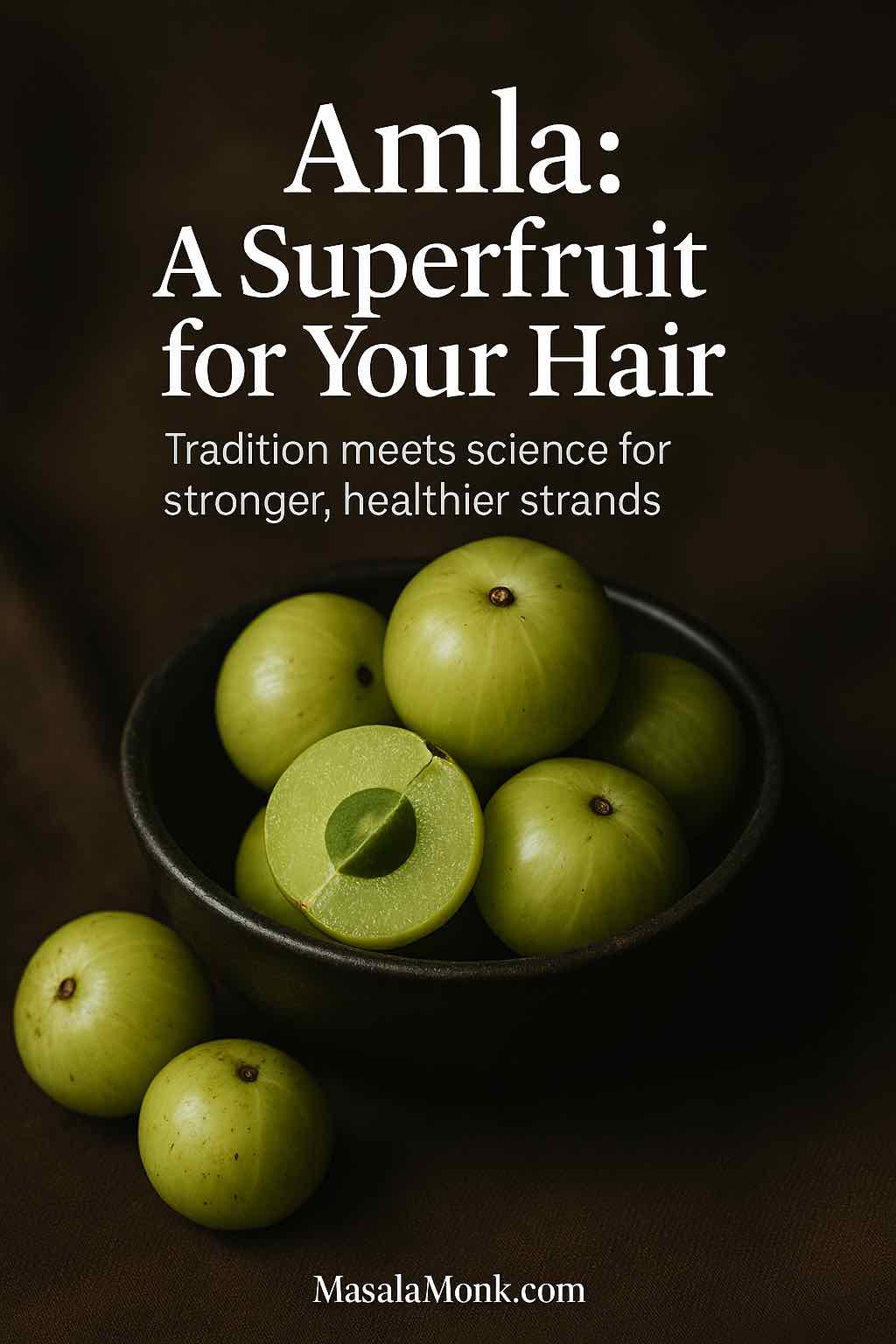
If you’ve ever sat with your grandmother or an Ayurvedic practitioner, chances are you’ve heard about the magic of amla for hair — that small, sour, green fruit also known as Indian Gooseberry. In India, amla is more than just a fruit; it’s a tradition. From oils to powders, shampoos to juices, amla has been woven into haircare routines for centuries.
But does this ancient wisdom hold up under the microscope of modern science? Surprisingly, yes. In fact, recent research confirms that amla doesn’t just have anecdotal value — it has clinically proven benefits for hair growth, hair strength, and scalp health.
So, whether you’re struggling with hair fall, premature greying, or simply dull strands that need life, amla might be the natural solution you’ve been looking for. And the best part? You can use it in many different ways — oil, powder, juice, or even supplements.
In this article, we’ll explore:
- The science-backed benefits of amla for hair.
- The different forms you can use (and how to use them effectively).
- Traditional wisdom blended with modern clinical trials.
- Practical tips you can start today.
By the end, you’ll know exactly why amla is called a superfruit for your hair — and how to bring it into your routine.
🌱 Why Amla is Good for Hair
Let’s begin with the basics: why is amla so powerful when it comes to hair?
The secret lies in its nutritional profile. Amla is packed with:
- Vitamin C: It contains nearly 20 times more Vitamin C than oranges. Vitamin C is essential for collagen production, which strengthens hair follicles and roots.
- Antioxidants: Polyphenols like gallic acid and ellagic acid protect your hair from oxidative stress (one of the main causes of premature greying and follicle damage).
- Iron and calcium: Minerals that support strong, healthy hair growth.
- Anti-inflammatory compounds: Help soothe the scalp and fight conditions like dandruff.
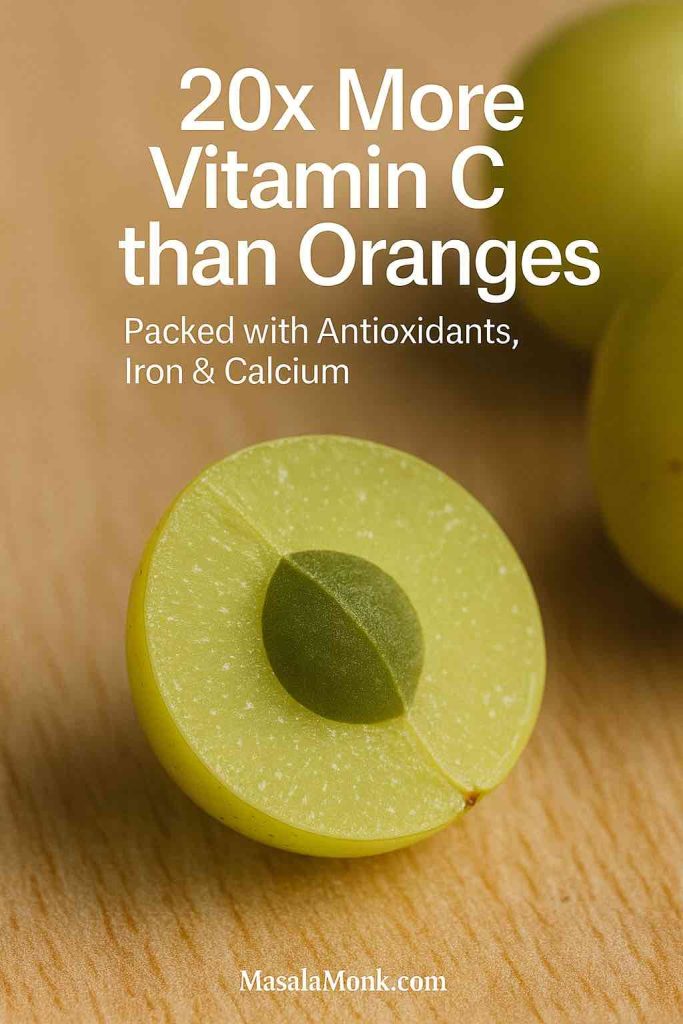
👉 What this means for you: whether you’re consuming amla or applying it topically, you’re delivering a cocktail of nutrients that nourish your hair at every level — root, strand, and scalp.
In fact, gooseberry is such a nutritional powerhouse that it even supports weight management and overall wellness (Gooseberry Nutrition & Weight Loss). Moving from nutrition to visible benefits, let’s look at what modern science says amla can actually do for your hair.
✨ Benefit #1: Amla Promotes Hair Growth
One of the top reasons people turn to amla is for faster, healthier hair growth. And guess what? Research confirms it works.
A 2024 clinical trial published in Journal of Ethnopharmacology tested oral amla syrup in women suffering from female pattern hair loss. After 12 weeks, participants showed a significant increase in the number of hairs in the anagen phase — that’s the active growth phase of the hair cycle (PubMed link). Similarly, other natural ingredients like lemon are also known to help your hair in different ways to know more, read – 6 Ways Lemon Helps Hair Growth.
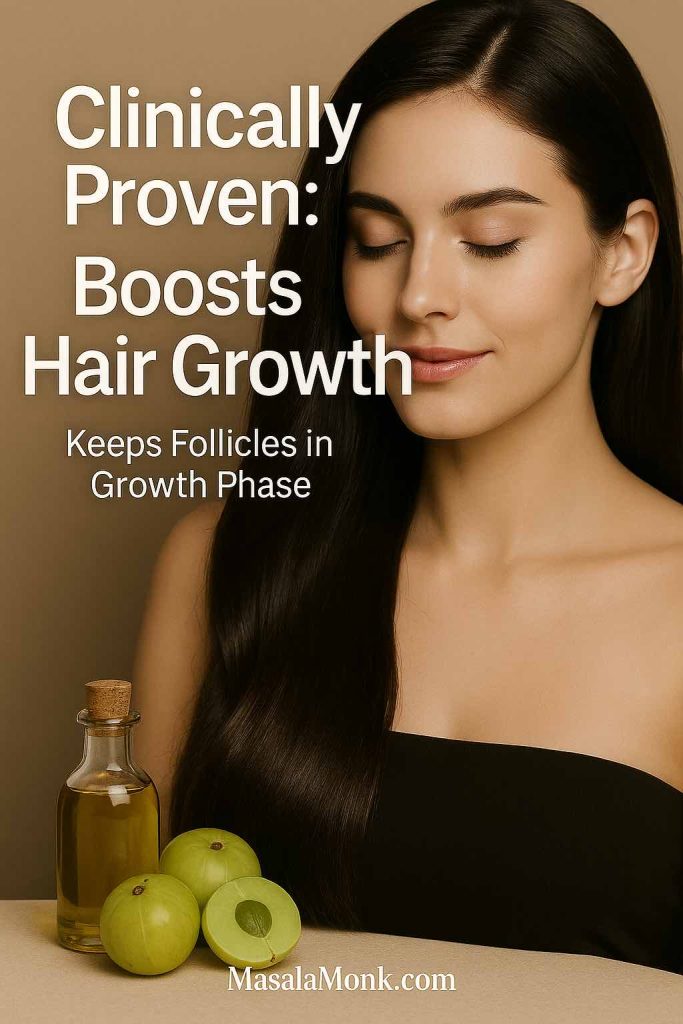
👉 In plain English: more of their hair stayed in the growth phase, rather than falling into the resting or shedding phase. Both patients and doctors noticed visible improvements.
Even at the cellular level, amla shows promise. Lab studies have demonstrated that amla extract stimulates dermal papilla cells — the tiny powerhouses inside each follicle that decide whether your hair grows or sheds (Mahidol University study).
👉 What this means for you: eating amla, drinking its juice, or taking supplements isn’t just a “feel-good” tradition. It can actually support the biological processes that encourage hair growth.
🍃 Benefit #2: Amla Reduces Hair Fall & Hair Loss
We’ve all had moments when the hairbrush reveals more hair than we’d like. Consistent hair fall can be frustrating — and often stressful in itself. Here’s where amla comes in as a natural ally.
In a 2025 trial with 300 participants, those who took amla tablets twice daily for three months reported a dramatic reduction in hair fall. The average hair fall score dropped from 6.2 to 3.4 on the Visual Analog Scale (VAS), a widely used tool in clinical studies (JAIMS study).
But that’s not all. Participants also noted improvements in:
- Hair shine and texture.
- Hair strength and volume.
- Scalp health.
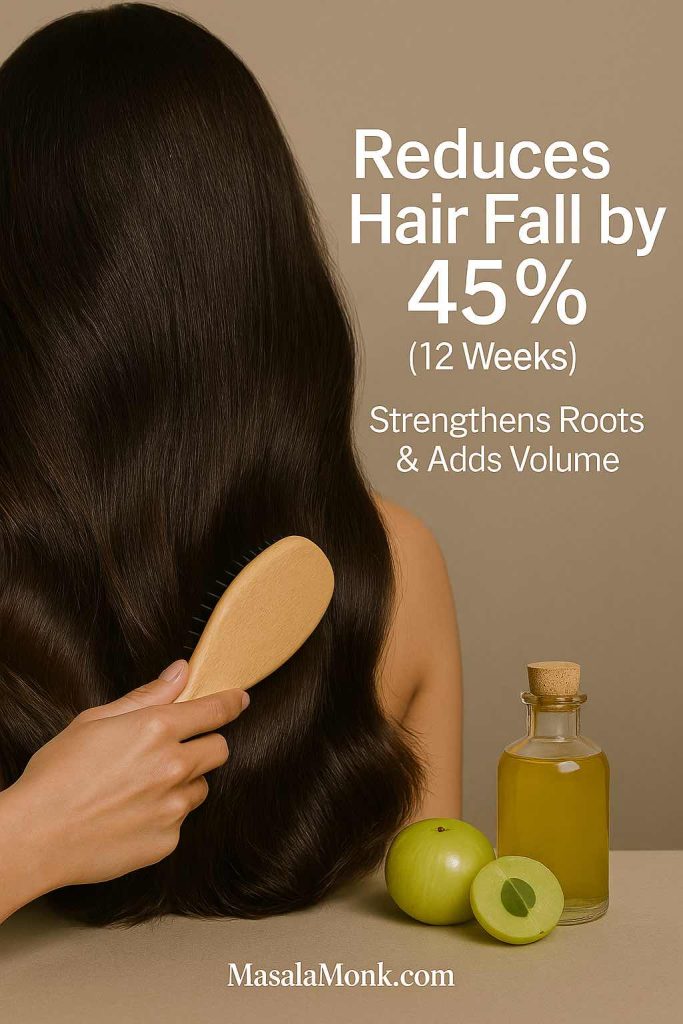
Interestingly, blood tests showed a rise in antioxidant levels, suggesting that amla doesn’t just work on the outside — it protects hair at the cellular level too. And it’s not just amla — foods rich in Vitamin E and biotin, like almonds, also help strengthen hair from within, read our post on Almond Benefits for Hair.
👉 What this means for you: if you struggle with chronic hair shedding, amla supplements or fresh amla in your diet can be a simple, side-effect-free way to get your hair back on track.
🌗 Benefit #3: Amla May Delay Premature Hair Greying
Few things are as frustrating as spotting that first grey strand earlier than expected. While genetics play a role, oxidative stress — essentially “rusting” at the cellular level — is one of the main culprits behind premature greying.
Here’s where amla shines. Its rich Vitamin C content and antioxidants help neutralize free radicals that damage pigment cells in hair follicles. These same antioxidant effects explain why amla is also celebrated for skin health and anti-aging (Amla Benefits for Skin). In Ayurveda, amla has long been used as a tonic to preserve natural hair color and vitality.
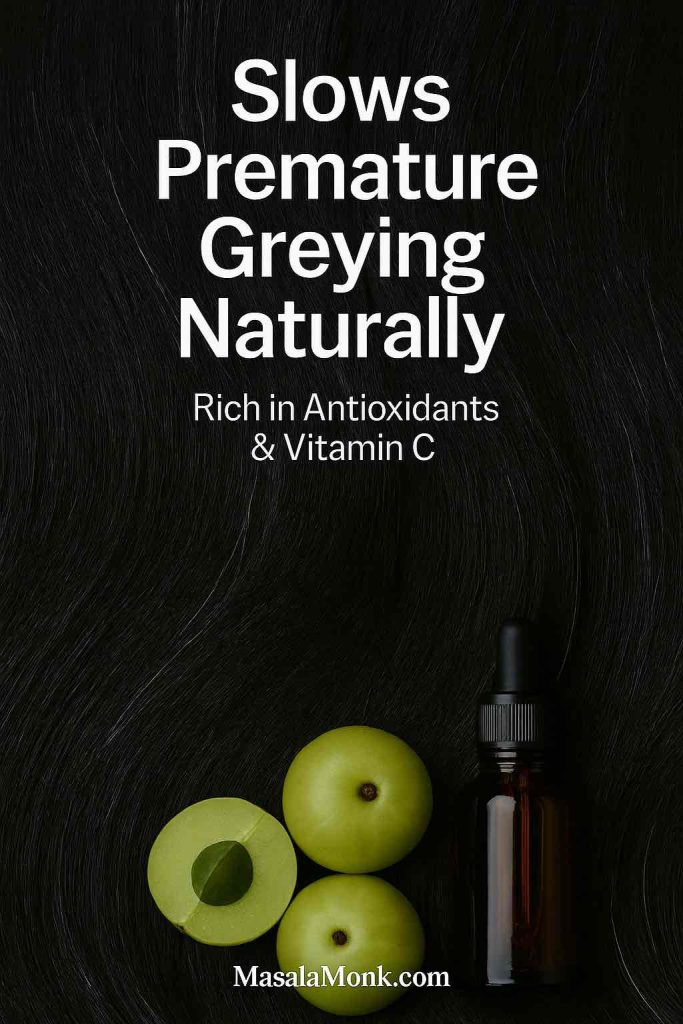
Modern science adds plausibility: antioxidants like gallic acid and ellagic acid, abundant in amla, protect melanocytes (the cells that give your hair its color). While we don’t yet have a 12-week “anti-grey” clinical trial, the antioxidant data is strong.
👉 What this means for you: while amla won’t magically reverse grey hair, regular use may slow down the greying process. Many people combine amla oil with henna for a natural, conditioning color boost that both hides and delays greys.
✨ Benefit #4: Adds Shine & Strengthens Hair Strands
Healthy hair doesn’t just grow fast — it looks shiny and feels strong. If your hair feels brittle, dry, or lifeless, amla can help.
A 2020 study in Applied Sciences tested amla extract on both virgin and bleached human hair fibers. The result? Treated hair showed higher tensile strength and flexibility than untreated hair (MDPI link).
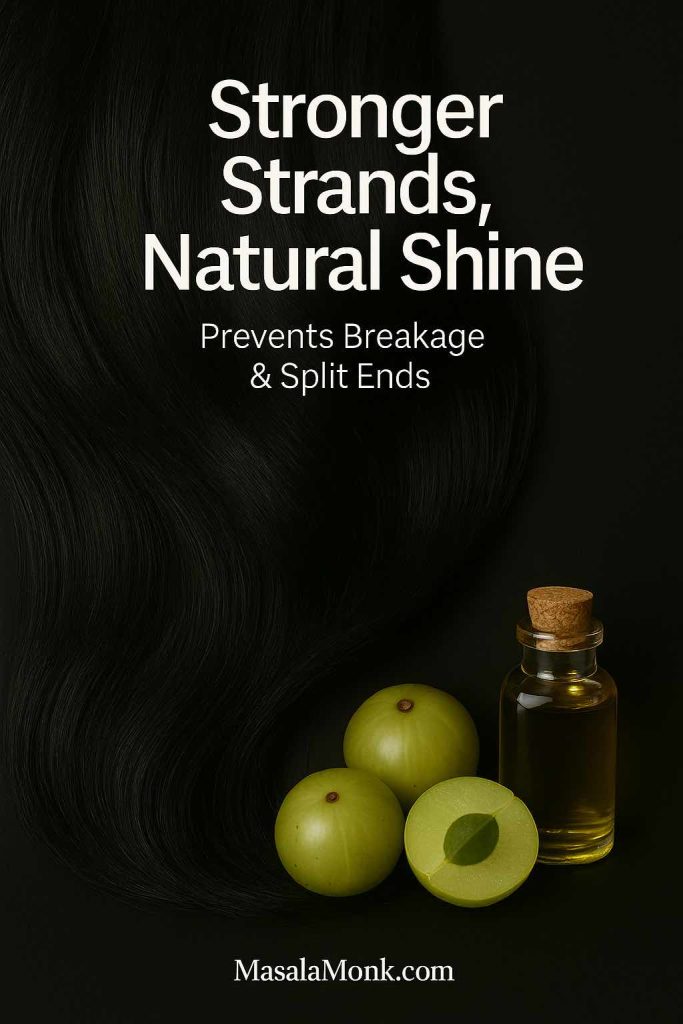
👉 In simpler terms: amla makes hair less likely to snap, break, or split.
Even if you heat-style, color, or chemically treat your hair, amla can offer a protective layer that reduces long-term damage.
👉 What this means for you: a regular amla oil massage or hair mask isn’t just nourishing — it’s a practical way to strengthen strands and bring back that natural shine.
🧴 Benefit #5: Amla Improves Scalp Health
Strong roots grow from a healthy scalp. Unfortunately, dandruff, itchiness, and inflammation can weaken follicles and trigger hair loss.
Amla’s antimicrobial and anti-inflammatory properties make it an excellent natural remedy for scalp health. In fact, a 2011 in-vitro study found that amla extract stimulated dermal papilla cells, the very cells that control follicle growth and hair cycling (Mahidol University study).
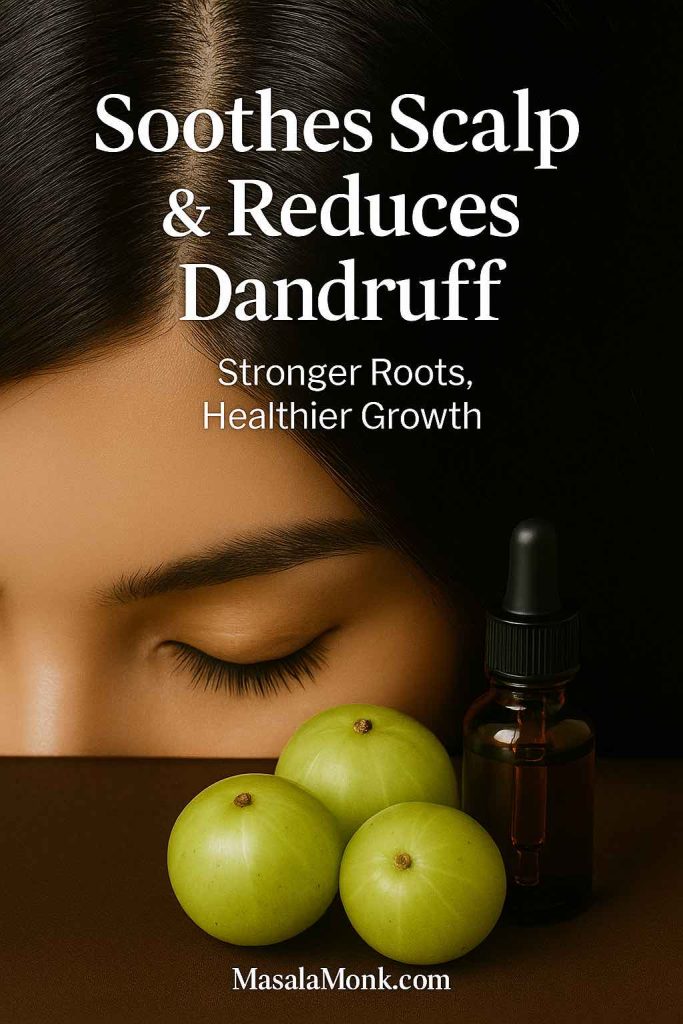
👉 Translation: amla helps keep the follicle environment active and balanced.
This means fewer scalp issues like dandruff and irritation, and a better foundation for stronger hair growth. For extra soothing, many people combine it with rose water rinses for hydration and scalp calm (Rose Water for Hair Care).
👉 What this means for you: using amla oil directly on your scalp or rinsing with diluted amla juice can calm irritation, reduce dandruff, and keep follicles healthy.
🥗 Benefit #6: Amla Nourishes Hair From Within
When we think of hair care, we often imagine oils, masks, and shampoos. But sometimes, the best treatment comes from the inside out.
Amla is a superfruit in every sense of the word. Eating it fresh, sipping on amla juice, or taking amla supplements delivers a burst of nutrients — Vitamin C, iron, calcium, antioxidants — directly into your bloodstream, where they can support your scalp and follicles. Its antioxidants don’t just help your hair — they also support your eyes and vision health (Amla and Eye Health) and even aid in conditions like blood sugar balance (Amla for Diabetes).
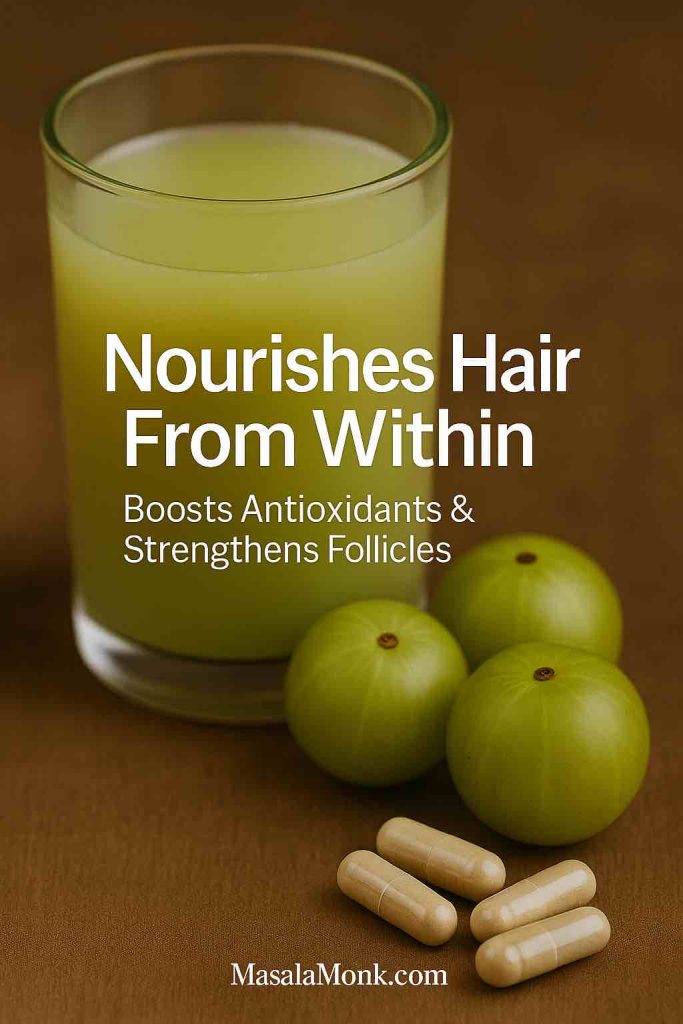
The 2025 Vedistry Amla Tablet trial on 300 people is a perfect example. After three months of supplementation, participants didn’t just notice less hair fall — they also reported better shine, strength, and scalp health. Blood tests revealed higher antioxidant levels, suggesting amla helps protect hair cells from oxidative stress (JAIMS study).
👉 What this means for you: sipping on fresh amla juice in the morning or adding a supplement to your routine can nourish your hair at the cellular level — keeping it strong, shiny, and resilient over time.
🌞 Benefit #7: Protects Against Environmental Damage
Between pollution, heat styling, harsh shampoos, and UV rays, our hair faces daily assaults. Over time, these stressors can cause thinning, dryness, and dullness.
Amla’s antioxidant-rich profile helps shield hair against environmental damage. And scientists are taking it seriously. In 2022, researchers tested amla extract-loaded transfersomes (tiny carriers designed to deliver actives deeper into the scalp). They found that the extract boosted hair-related gene expression in skin cells and enhanced antioxidant activity (PubMed study).

👉 While this is still early research, it shows that amla isn’t just an “old wives’ tale.” It has potential to inspire the next generation of advanced haircare products.
👉 What this means for you: while you don’t need lab-grade transfersomes, regular amla use — whether oil, mask, or rinse — creates a protective barrier that helps your hair stay healthier in the face of everyday stress.
🛠️ How to Use Amla for Hair
Now that we know what amla can do for your hair, the next question is simple: how do you actually use it?
The beauty of amla is its versatility. You can use it as an oil, mix it into DIY masks, drink its juice, or even find it in shampoos and conditioners. Let’s break it down.
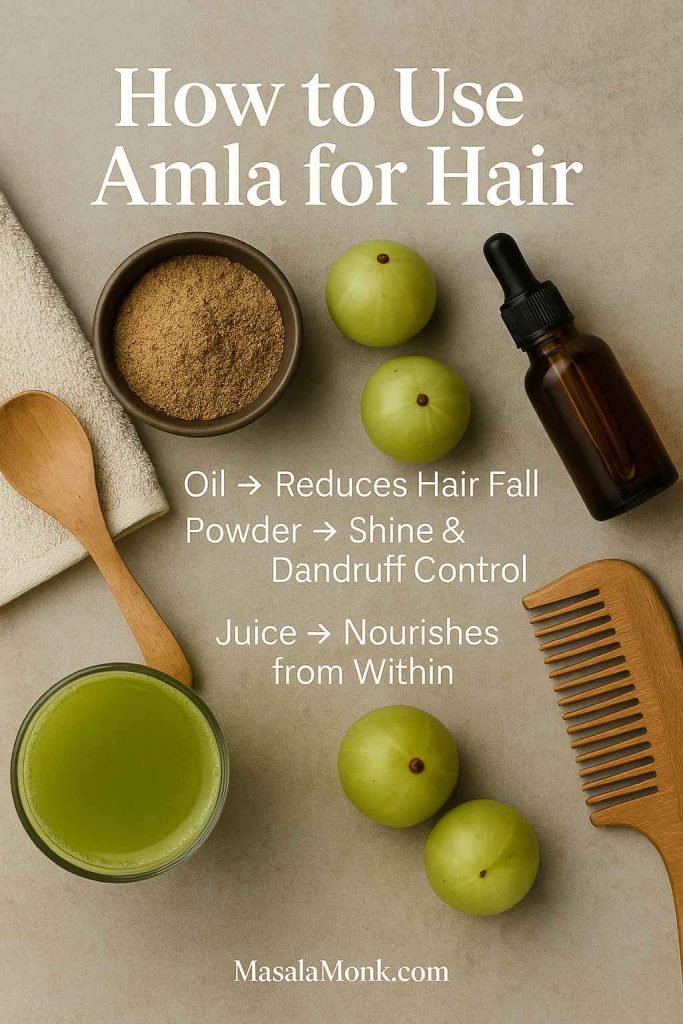
💧 1. Amla Oil for Hair
Perhaps the most popular form, amla oil is a staple in Indian households.
How to use it:
- Warm 2–3 tablespoons of pure amla oil (don’t overheat).
- Massage gently into your scalp in circular motions.
- Work the oil down to the tips of your hair.
- Leave it overnight, then wash with a mild shampoo.
Frequency: 1–2 times per week.
Why it works: Oils act as carriers, allowing amla’s antioxidants and Vitamin C derivatives to penetrate the scalp. Massage also improves blood circulation, which further boosts growth.
👉 What this means for you: Regular oiling can reduce hair fall, delay greying, and leave your hair softer and shinier.
Pro tip: Mix amla oil with coconut oil for deep conditioning, or with rosemary oil for a modern Ayurvedic twist (rosemary itself is clinically proven for hair growth).
🌿 2. Amla Powder for Hair
Amla powder is made from dried, ground amla fruit — and it’s incredibly versatile.
How to use it (basic mask):
- Mix 2 tablespoons of amla powder with warm water to make a paste.
- Apply to scalp and hair.
- Leave for 30–40 minutes.
- Rinse thoroughly with lukewarm water.
Popular combos:
- Amla + yogurt → anti-dandruff pack.
- Amla + henna → natural hair color + nourishment.
- Amla + aloe vera → hydration boost.
- Amla + reetha & shikakai → natural shampoo alternative.
Science tie-in: Amla’s antioxidants in powder form still provide follicle stimulation and scalp protection, though effects may vary depending on concentration.
👉 What this means for you: If you prefer natural DIY care, amla powder is your best friend. It cleanses, conditions, and strengthens — all without chemicals.
🥤 3. Amla Juice for Hair
Hair care doesn’t have to stop at the scalp — nourishing your body helps nourish your hair.
How to use it:
- Drink 30–50 ml of fresh amla juice daily (dilute with water if too sour).
- Alternatively, use amla juice as a final hair rinse after shampooing.
Science tie-in: In the 2025 clinical trial, oral amla tablets boosted antioxidants in the blood and significantly reduced hair fall. Juice offers similar internal benefits.
👉 What this means for you: think of amla juice as a daily vitamin shot for your hair — working from the inside out.
🧴 4. Amla Shampoo & Conditioner for Hair
Not everyone has time for masks and oils. Thankfully, many herbal shampoos and conditioners now feature amla as a key ingredient.
How to use it:
- Use 2–3 times a week, alternating with a mild, sulfate-free shampoo.
- Look for formulas combining amla with reetha and shikakai for cleansing and strengthening.
👉 What this means for you: herbal shampoos give you a simple, no-fuss way to bring amla into your routine — perfect if you’re busy but still want healthier hair.
🥣 5. DIY Hair Masks with Amla
If you love kitchen beauty recipes, amla is incredibly fun to play with.
Recipes to try:
- Amla + Yogurt Mask: for dandruff and flaky scalp.
- Amla + Henna Pack: for natural coloring and grey coverage.
- Amla + Aloe Vera Gel: for hydration and shine.
- Amla + Coconut Milk: for deep nourishment.
How to use:
- Mix 2–3 tablespoons of amla powder with your chosen base.
- Apply generously from roots to tips.
- Leave for 30–45 minutes.
- Rinse with lukewarm water.
👉 What this means for you: masks are a budget-friendly way to get salon-like results at home. And with regular use, they can tackle specific concerns like dandruff, dryness, or dullness.
🌟 Which Form of Amla Should You Choose?
- Use amla oil → if your main concern is hair fall or dryness.
- Try amla powder packs → if you love DIY and want shine + dandruff control.
- Drink amla juice or take supplements → if you want stronger hair from within.
- Switch to amla shampoos → if you want quick, everyday convenience.
👉 Ideally, combine one internal (juice, supplement, or fresh amla) + one external method (oil or mask) for the best results.
🌿 Best Amla Combinations for Hair
One of the reasons amla has stood the test of time is its versatility. In Ayurveda, amla is rarely used in isolation — it’s often combined with other herbs to create powerful hair tonics. Ayurveda often blends herbs. For instance, Amla is sometimes paired with Tulsi, Ashwagandha, and Turmeric for broader wellness benefits (Amla, Tulsi & Ashwagandha Combo). When paired thoughtfully, these combinations amplify amla’s benefits and target specific hair concerns.
Here are some of the most effective blends you can try:
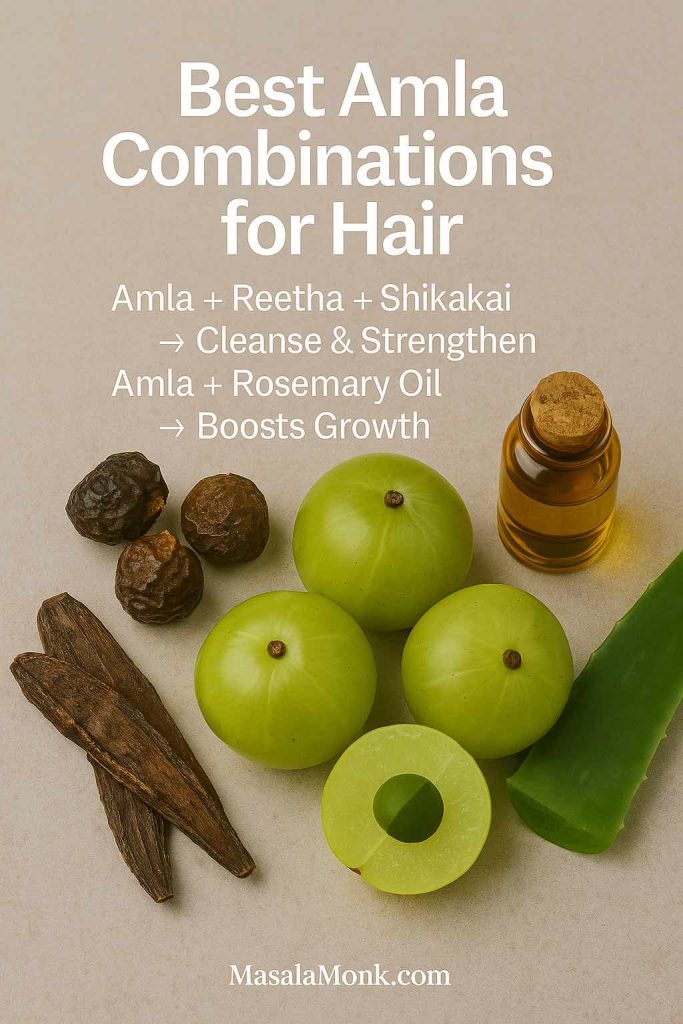
🧴 Amla + Reetha + Shikakai
This trio is perhaps the most famous Ayurvedic hair care blend.
- Reetha (soapnut) acts as a natural cleanser, gently removing dirt and oil without harsh sulfates.
- Shikakai is known as a natural conditioner, leaving hair soft and manageable.
- Amla strengthens roots, boosts growth, and adds shine.
How to use:
- Mix equal parts amla, reetha, and shikakai powder with warm water.
- Apply as a paste, leave for 20–30 minutes, then rinse.
- Or boil the three herbs in water overnight, strain, and use as a herbal shampoo.
👉 What this means for you: if you want a chemical-free hair wash that cleanses, conditions, and strengthens in one step, this combination is unbeatable.
🌱 Amla + Brahmi
Brahmi is another revered Ayurvedic herb often used to calm the mind and strengthen the nervous system. Applied to hair, it helps soothe the scalp and reduce stress-related shedding.
How to use:
- Mix 2 tablespoons amla powder + 2 tablespoons brahmi powder with yogurt or aloe vera gel.
- Apply as a mask for 30–40 minutes.
👉 What this means for you: perfect for anyone experiencing stress-related hair fall or scalp inflammation.
🌿 Amla + Rosemary Oil
While amla is ancient, rosemary oil is a more modern favorite, backed by studies showing it may be as effective as minoxidil for promoting hair growth. When combined, you get the best of both worlds: Ayurveda + modern herbal science.
How to use:
- Mix a few drops of rosemary essential oil into 2–3 tablespoons of warm amla oil.
- Massage into the scalp 2–3 times per week.
👉 What this means for you: a simple yet powerful blend for anyone focused on hair growth and reducing thinning.
🌾 Amla + Henna
For centuries, women across India have combined amla with henna for natural coloring and conditioning. Henna strengthens and coats the hair shaft, while amla enhances the dye uptake and prevents the red tone from being too bright.
How to use:
- Mix henna powder with warm water and let it rest overnight.
- Add 2–3 tablespoons of amla powder before applying.
- Apply the paste to hair, leave for 1–2 hours, and rinse.
👉 What this means for you: a natural solution if you want to cover greys, condition hair, and add shine without chemical dyes.
🍃 Amla + Aloe Vera
Aloe vera is known for its cooling, hydrating, and healing properties. When paired with amla, it creates a soothing mask for the scalp while hydrating dry, brittle hair.
How to use:
- Mix 2 tablespoons of amla powder with fresh aloe vera gel.
- Apply to scalp and hair, leave for 30 minutes, then rinse.
👉 What this means for you: an ideal pack for dry scalp, dandruff, or frizzy hair.
✅ Choosing the Right Combo
- For cleansing & strengthening → Amla + Reetha + Shikakai.
- For stress-related hair fall → Amla + Brahmi.
- For boosting growth → Amla + Rosemary Oil.
- For covering greys → Amla + Henna.
- For hydration & dandruff → Amla + Aloe Vera.
❓ Frequently Asked Questions About Amla for Hair
1. Is amla really good for hair growth?
Yes. Both traditional Ayurveda and modern clinical trials confirm that amla supports hair growth. In a 2024 clinical study, women taking amla syrup for 12 weeks had significantly more hairs in the growth phase compared to placebo (PubMed link).
👉 In short: amla doesn’t just make your hair look healthier — it works at the follicle level to support real growth.
2. Does eating amla help with hair?
Absolutely. Internal nutrition is just as important as external care. Eating fresh amla, drinking amla juice, or taking supplements can supply antioxidants, Vitamin C, and minerals directly to your hair roots. A 2025 study on 300 participants found that oral amla tablets significantly reduced hair fall and improved shine, strength, and scalp health (JAIMS link).
3. Can amla reverse grey hair?
No — once hair has turned grey, amla cannot bring the pigment back. However, its antioxidant properties may slow down premature greying by protecting pigment cells. That’s why amla is often used in combination with henna for a natural coloring and conditioning effect.
4. Which is better: amla oil or powder?
It depends on your lifestyle and goals.
- Amla oil → best for scalp massage, reducing hair fall, and nourishing roots.
- Amla powder → best for DIY masks that cleanse, condition, and add shine.
👉 Tip: for best results, combine them — oil for weekly massages, powder masks for monthly treatments.
5. How often should I use amla for hair?
- Amla oil massage → 1–2 times per week.
- Amla powder mask → once every 2–3 weeks.
- Amla juice or supplements → daily for internal nourishment.
- Amla shampoo → 2–3 times per week, alternating with a mild cleanser.
6. Is amla safe for everyone?
Yes, amla is generally safe when used as food, oil, or topical application. In clinical trials, only mild side effects were reported (e.g., one case of mild constipation with oral syrup). If you’re allergic to gooseberries or have a sensitive scalp, patch test before use.
But if you’re pregnant, check this detailed guide first: Is it Safe to Eat Amla During Pregnancy?.
🌟 Conclusion: Amla — A Timeless Secret, Now Backed by Science
From Ayurvedic hair oils passed down through generations to cutting-edge clinical trials, amla has proven its worth. This humble fruit truly deserves its reputation as a superfood for hair.
- It promotes growth by stimulating follicles.
- It reduces hair fall and strengthens roots.
- It protects against breakage, greying, and scalp issues.
- And most importantly, it works inside and out — nourishing your body and your hair.
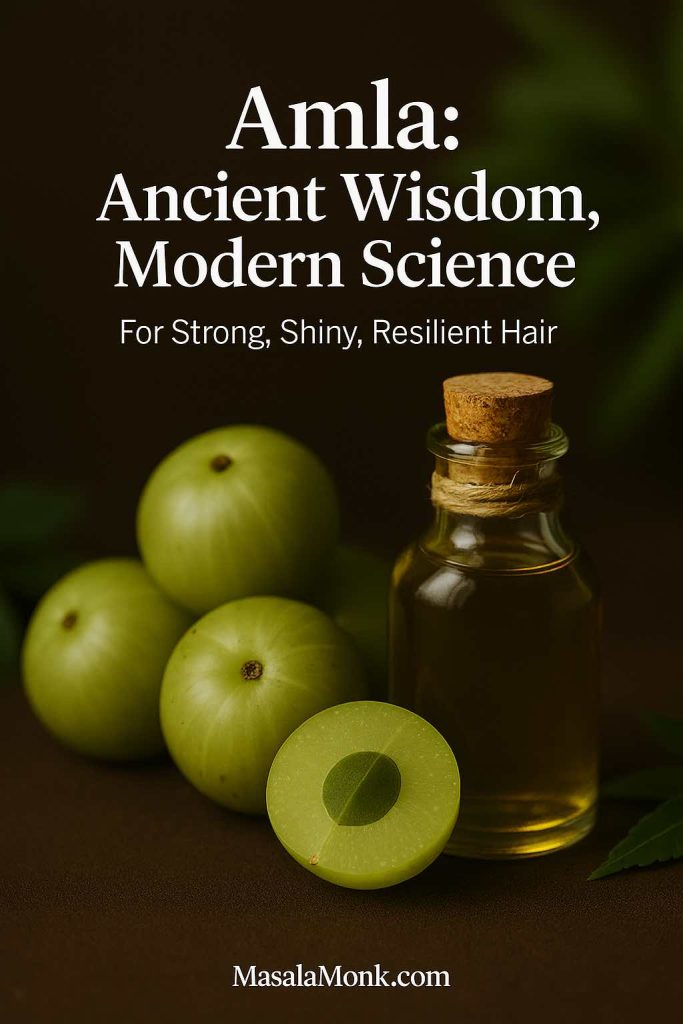
👉 What this means for you: whether you choose to sip on amla juice, massage in amla oil, or whip up a DIY mask, you’re tapping into a tradition that’s now reinforced by modern science.
So maybe grandma was right after all — a little amla a day really does keep bad hair days away. 🌿✨
And it’s not alone — garlic and other natural ingredients also show remarkable results for scalp health and growth (Garlic for Hair). Combining them can give you a holistic, nature-powered haircare routine.

